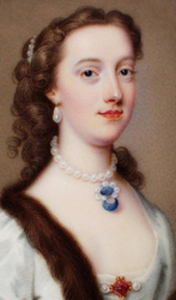Biography
Margaret Cavendish was born in 1623 in Colchester, Essex to Sir Thomas Lucas and his wife, Elizabeth. She was their eighth child, all of which were taught reading and writing by an elderly gentlewoman. Margaret and her sisters also learned needlework, singing, dancing, and to play the lute and the virginal. She was noted as being meditative rather than animated.
than animated.
Throughout her childhood, Margaret had a relationship with her family that was full of love. At a young age, she developed a desire to be known as a wit and a beauty, which is evidenced in her works of literature. Her first attempts at writing were what she called her "baby books," of which she wrote sixteen. Through her writing, she developed a yearning to excel in literature.
When the civil war broke out in England in 1640, Margaret became a maid-of-honor to Queen Henrietta Maria. Margaret was further separated from her family when the Queen and her court were forced to flee into exile in France, where she was forced to spend the next eighteen years impoverished. While she was in exile, she began to write about natural philosophy. A leitmotif in her books includes a lady who flees to foreign lands and endures many hardships, a theme that had undoubtedly developed from these traumatic events.
While in France, Margaret met William Cavendish, the first Duke of Newcastle, and they got married in 1645. In her autobiography, Margaret wrote that she dreaded marriage and only married William because he was a worthy man, full of wit, and respectful. Living a life of almost poverty during the Interregnum, Margaret received informal lessons in science and philosophy from her husband and his brother, Sir Charles. She developed an enthusiasm for science that is reflected in her books and poems.
When Margaret returned to England in 1651, she spent much of her time writing Poems and Fancies, a collection of poems. While loved by some and criticized by many, she remained an undeterred self-publicist, publishing under her  own name even though she was a woman.
own name even though she was a woman.
Margaret spent much of her life studying natural philosophy, and was the first woman to do many things; she did so while displaying brilliance and a freedom of thought in her works of science fiction. She was the first woman in England who wrote mainly for publication, and was continuously boldly feminist. One of her greatest triumphs was her famous visit to the Royal Society in 1667, where she was able to speak about her views on philosophy.
She published twenty-two works in her lifetime.
When she was fifty years old, she died suddenly on December 15, 1673.
Biography adapted from:
http://luminarium.org/sevenlit/cavendish
Paper Bodies, A Margaret Cavendish Reader, Edited by Sylvia Bowerbank and Sara Mendleson
Early Women Writers: 1600-1720 by Anita Pacheco
 than animated.
than animated.  than animated.
than animated.  own name even though she was a woman.
own name even though she was a woman.